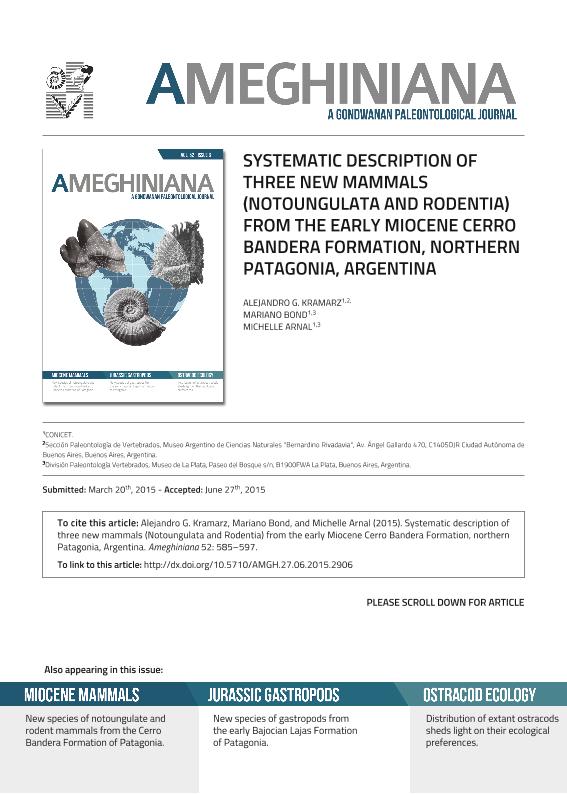Mostrar el registro sencillo del ítem
dc.contributor.author
Kramarz, Alejandro Gustavo

dc.contributor.author
Bond, Mariano

dc.contributor.author
Arnal, Michelle

dc.date.available
2018-06-05T17:28:33Z
dc.date.issued
2015-12
dc.identifier.citation
Kramarz, Alejandro Gustavo; Bond, Mariano; Arnal, Michelle; Systematic description of three new mammals (Notoungulata and Rodentia) from the Early Miocene Cerro Bandera Formation, northern Patagonia, Argentina; Asociación Paleontológica Argentina; Ameghiniana; 52; 6; 12-2015; 585-597
dc.identifier.issn
0002-7014
dc.identifier.uri
http://hdl.handle.net/11336/47331
dc.description.abstract
La Formación Cerro Bandera es una unidad continental mayormente piroclástica expuesta en áreas aisladas en el centro-Este de la Provincia de Neuquén, Noroeste de Patagonia. Varios mamíferos de estos depósitos fueron reportados previamente sustentando una Edad Colhuehuapense (Mioceno temprano) para estos niveles. Nuevos hallazgos revelan que esta unidad porta una asociación mucho más diversa y cuestionan esta edad. Aquí se describen tres nuevas especies. Protypotherium sinclairi sp. nov. (Notoungulata, Interatheriidae) es similar en tamaño a Protypotherium australe Ameghino (Santacrucense), pero difiere de todas las especies del género por tener los talónidos de p3–p4 menos reducidos. Doryperimys olsacheri gen. et sp. nov. (Rodentia, Neoepiblemidae) tiene molariformes hipselodontes, prismáticos, con caracteres combinados de las especies de Perimys Ameghino y de Scotamys antiquus Loomis. La posición sistemática de Leucokephalos maior sp. nov. dentro de los Caviomorpha aún es incierta, pero está definitivamente relacionado a Leucokephalos zeffiae Vucetich, Dozo, Arnal, and Pérez (Deseadense) por compartir molarifomes radiculados con una casi idéntica simplificación oclusal temprana que recuerda a la configuración en forma de ocho de algunos octodontoideos tempranos y supuestos chinchilloideos. Las tres especies ocurren positivamente en la misma localidad y nivel estratigráfico en el faldeo nororiental de la Barda Negra; P. sinclairi y D. olsacheri también se registran en otros niveles expuestos en diferentes afloramientos aislados de la Formación Cerro Bandera. Doryperimys olsacheri, así como otros roedores de esta unidad previamente descriptos, es desconocido en otras asociaciones de mamíferos presumiblemente coetáneas, pero el significado biocronológico y paleobiogeográfico de esta asociación aún está bajo estudio.
dc.description.abstract
The Cerro Bandera Formation is a mostly pyroclastic continental unit exposed in isolated areas of east-central Neuquén Province, northwestern Patagonia. Several mammals from these deposits were previously reported and support a Colhuehuapian age (early Miocene) for these levels. New findings reveal that this unit bears a much more diverse assemblage and calls into question this age assessment. Here we describe three new species. Protypotherium sinclairi sp. nov. (Notoungulata, Interatheriidae) is similar in size to the Santacrucian Protypotherium australe Ameghino, but differs from all the species of the genus by having less reduced p3–p4 talonids. Doryperimys olsacheri gen. et sp. nov. (Rodentia, Neoepiblemidae) has hypselodont, prismatic cheek teeth that combine features of species of Perimys Ameghino and Scotamys antiquus Loomis. The systematic position of Leucokephalos maior sp. nov. within Caviomorpha is still uncertain, but it is definitively allied to the Deseadan Leucokephalos zeffiae Vucetich, Dozo, Arnal, and Pérez in sharing rooted cheek teeth with an almost identical early occlusal simplification that resembles the 8-shaped configuration of some early octodontoids and putative chinchilloids. The three species co-occur at a single fossil locality and stratigraphic level on the northeastern slope of Barda Negra; P. sinclairi and D. olsacheri are also recorded in other levels exposed in different isolated outcrops of the Cerro Bandera Formation. Doryperimys olsacheri –like other previously described rodents from this unit– is unknown in other presumably coeval mammal associations, but the biochronological and paleobiogeographic meaning of this assemblage is still under study.
dc.format
application/pdf
dc.language.iso
eng
dc.publisher
Asociación Paleontológica Argentina

dc.rights
info:eu-repo/semantics/openAccess
dc.rights.uri
https://creativecommons.org/licenses/by-nc-sa/2.5/ar/
dc.subject
Notoungulata
dc.subject
Caviomorpha
dc.subject
Neuquén
dc.subject
Sistemática
dc.subject
Cerro Bandera
dc.subject
Miocene Temprano
dc.subject
Patagonia
dc.subject.classification
Meteorología y Ciencias Atmosféricas

dc.subject.classification
Ciencias de la Tierra y relacionadas con el Medio Ambiente

dc.subject.classification
CIENCIAS NATURALES Y EXACTAS

dc.title
Systematic description of three new mammals (Notoungulata and Rodentia) from the Early Miocene Cerro Bandera Formation, northern Patagonia, Argentina
dc.type
info:eu-repo/semantics/article
dc.type
info:ar-repo/semantics/artículo
dc.type
info:eu-repo/semantics/publishedVersion
dc.date.updated
2018-05-23T16:34:17Z
dc.identifier.eissn
1851-8044
dc.journal.volume
52
dc.journal.number
6
dc.journal.pagination
585-597
dc.journal.pais
Argentina

dc.journal.ciudad
Ciudad Autónoma de Buenos Aires
dc.description.fil
Fil: Kramarz, Alejandro Gustavo. Consejo Nacional de Investigaciones Científicas y Técnicas. Oficina de Coordinación Administrativa Parque Centenario. Museo Argentino de Ciencias Naturales "Bernardino Rivadavia"; Argentina
dc.description.fil
Fil: Bond, Mariano. Consejo Nacional de Investigaciones Científicas y Técnicas. Centro Científico Tecnológico Conicet - La Plata; Argentina. Universidad Nacional de La Plata. Facultad de Ciencias Naturales y Museo. División Paleontología Vertebrados; Argentina
dc.description.fil
Fil: Arnal, Michelle. Universidad Nacional de La Plata. Facultad de Ciencias Naturales y Museo. División Paleontología Vertebrados; Argentina. Consejo Nacional de Investigaciones Científicas y Técnicas. Centro Científico Tecnológico Conicet - La Plata; Argentina
dc.journal.title
Ameghiniana

dc.relation.alternativeid
info:eu-repo/semantics/altIdentifier/doi/http://doi.org/10.5710/AMGH.27.06.2015.2906
dc.relation.alternativeid
info:eu-repo/semantics/altIdentifier/url/http://www.ameghiniana.org.ar/index.php/ameghiniana/article/view/2906
dc.relation.alternativeid
info:eu-repo/semantics/altIdentifier/url/http://www.bioone.org/doi/10.5710/AMGH.27.06.2015.2906
Archivos asociados
